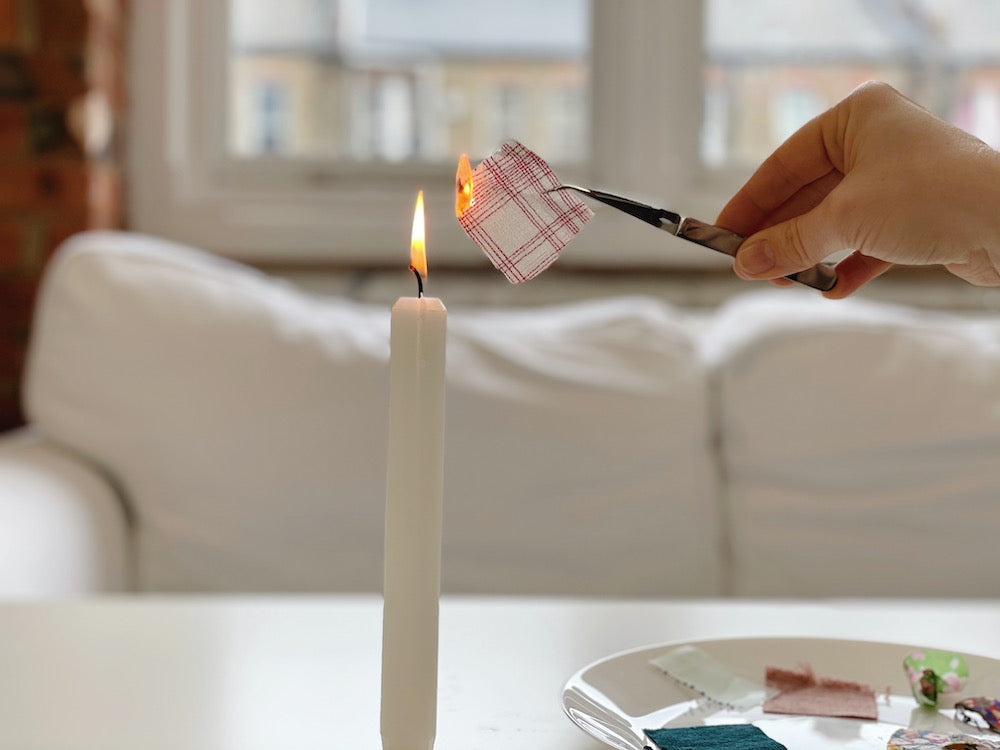
No doubt about it, I have a million and one things to be getting on with today. So, obviously, I’ve decided to organise my fabric stash instead! As I begin to sort through the unruly pile I’ve got crammed in various boxes, drawers and cupboards, creating sub-piles categorised by colour and fabric content, it occurs to me that the ‘unknown’ sub-pile is becoming distressingly large. How am I supposed to make a handy little swatch booklet of all my available fabrics if I don’t even know the fibre content of half of them?! Time to start playing with fire…
By burning small swatches of a mystery fabric, and analysing how the fabric burns, what it smells like and what sort of residue is left over, we can get pretty close - if not bang on - to identifying the fibre the fabric is made up of. Here's how it's done:
How to identify fabric content with a trial by fire
To begin with you’ll need to gather some samples of your mystery fabrics, cut up into little squares. You’ll also need a pair of tweezers to protect your fingers, a lighter or candle (avoid matches as they burn out too quickly and smell all match-y, meaning that you’ll have a harder time identifying the smell of your mystery fabrics as they burn), and a baking tray to conduct your experiments in. You might also want to have a glass of water to hand in case things get out of control...

As you hold your fabric swatch in the flame, you want to be asking yourself the following questions:
- How quickly does the fabric ignite as it approaches the flame? Is it catching fire easily, or is it curling away from the flame?
- Is it charring, or is it melting?
- What smell does it give off as it burns?
- When you remove the swatch from the flame, does it continue to burn, or does it go out right away?
- Finally, what do the burnt remains look like?
Plant based fibres
Generally speaking, plant based fabrics like cotton, linen, bamboo and rayon will ignite quickly and burn easily, giving off a smell of burnt paper, leaves or wood and result in flaky, ashy remains.
This shows a swatch of quilting cotton being burned. It ignited easily and burned bright, smelling like burning paper. I had to blow it to put the flame out, and what was left was blackened, flaky ash.


This shows a swatch of linen. It burned similarly to the cotton, although slightly less bright. The smell was the same of burning paper, but the ashy remains were much paler in colour. I have also heard that burning linen can also smell a bit like burning dried grasses, which makes total sense considering its origin.


Synthetics
Synthetic fibres such as polyester, acetate and nylon typically melt under high heat and give off a chemical/plasticky odour, leaving you with a hard, shiny plastic-like bead.
This shows a swatch of polyester. It ignited easily but burned briefly and immediately started to melt, and smelled like sweet chemicals. The residue was a shiny hard plastic-like bead.


This shows a swatch of nylon. The only real difference between this one and the polyester was the smell, which really did smell like celery gone a bit bad! More acrid than the sweeter smelling polyester, but still very chemical. The hardened melted remains were also paler in colour.


Animal fibres
Fabrics made from animal fibres such as wool and silk don't ignite so easily, curling slightly away from the flame. As they burn they smell like burning hair and leave a hard ash/bead-like residue that is easily crushed to powder between your fingers.
This shows a swatch of pale green silk organza. The fabric recoils slightly as it burns, making a gentle hissing sound and smelling like burnt hair. The flame burns slowly and goes out, leaving soft beads that are easily crushed between the fingers.


This shows a swatch of wool being burned. It burns slowly, smelling like burning hair and leaves a dark, hard ash that crushes easily.


But how can you narrow it down even further? Distinguish your silk from your wool, cotton from rayon, polyester from acrylic? Luckily, we’ve created a handy little flow chart to help you in your diagnosis, which, if you feel like printing out and laminating, I won’t judge.

A word on mixed fibre fabrics: So what about that squeaky ‘wool-blend’ fabric you picked up in in the remnants bin?? If a fabric is a mix of different fibres, say wool and polyester, or cotton and rayon, the burn test won’t have such defined results as the actual threads used to weave the fabrics will already be blended. However, once you familiarise yourself with how single fibre fabrics react, making an educated guess if you see two reactions happening within one swatch should give you a fairly accurate idea as to what you’re working with.

I was interested to burn this swatch pictured above as I already knew it was a viscose silk blend. Sure enough, as it burned, I could distinctly smell both paper and hair. The ashy charred remains looked more like that of viscose, implying that the viscose content is most likely higher than the silk content.
***
I hope this has been helpful! I loooove geeking out over fabrics and have always found a good ole burn test to be very accurate and informative. Needless to say, please always be super careful when dealing with fire - don't leave the flame unattended, make sure you have something like water handy in case you need to put it out, and don't do this around children or animals. Be sensible, stay safe!

Comments on this post (2)
Thank you. The pictures add to the excellent descriptions. AND a handout. It’s my turn now.
— Alice
Thank you for your very clear explanation and detailed flow chart.
— Ann Lane